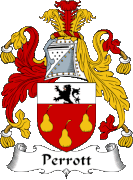The Plague In Haverfordwest
1651-1652
by Wayne Parrott (775)
I ran across the rather grim article Phillips J. 1895, The Plague at Haverfordwest, 1651-1652, Archaelogica Cambrensis Fifth Series XII(66):81-95 while looking for something else. What follows is an abstract and a few selected quotes from the article.
The plague arrived in Haverfordwest in October of 1651. By then Sir James Perrot was dead, and the Perrot properties in Pembrokeshire had left the main family and became the property of Sir Herbert Perrot from Herefordshire, a distant kinsman of Sir James on the Perrot side.
By year’s end 46 were dead. “1652 opened gloomily. On New Year’s Day (March 25th) there were three deaths; two of these were Parrotts. At the mayor’s expense two shrouds were delivered to Walter Parrott, who had already lost a child on the 13th. There were three deaths on the 27th, and four on the 28th. On the 29th ‘Walter Parrott and Margrett his wife followed their children to the tomb. One can understand the terror which the epidemic inspired.”

As the death toll escalated with the arrival of warmer weather, the church took its measures, extolling the villagers to “walk more closely with God hereafter, and to avoyd the occasion of all sins, especially swearing, Sabbath breaking, lyeing, drunkennesse, lasciviousnesse, mallice, envie, uncharitablenesse, which is rife in children as men.”
The civil authorities did likewise, “Tuesday evening, the 24th, one of the constables of Prendergast brought to the mayor a warrant, directed to them by Bulton Ormond, a High Constable of Dungleddy Hundred, requiring them ‘not to permit anie to come into the house, or anie townsman to come thiere,’ and threatening ‘that if anie shall goe or traffique with the townsmen theire houses shall be shutt up untill it please God to withdraw his scourge from you.'” The mayor did not abide by such strict measures, but did set up pest-houses for the afflicted.
The warrant was also addressed to Herbert Perrot, who was clearly expected to to do something. He and the mayor went to London to seek help. In response, “On Sunday the 2nd of May, Haverfordwest was specially prayed for ‘in the Chappel of Whitehall and in St. Laurence in London.” They do not appear to have succeeded in getting any other assistance, and the situation in Haverfordwest continued to worsen. Desperate for help, the Haverfordwest magistrates issued “a certificate …, setting forth the sad. miserable, distressed condition of the said towne. 990 persons or so, are thereabouts, as we are credibly informed, are in want of the necessary foode to sustaine nature” and proceeded to enact a tax so as to raise relief funds.
By July 7th, an additional 213 deaths had taken place, but a steady tax revenue stream was coming in by then to help handle the emergency. Forty one more deaths were reported the next three months. “The imagination is irresistibly fascinated by the grim tragedies that can be read between the lines of the official reports.” Mercifully, the last the last death recorded on 18 September, two weeks short of a full year after it started.
